Brooklyn Community Health Assessment: Identifying Risks & Promotion
VerifiedAdded on 2023/06/14
|5
|1077
|395
Report
AI Summary
This report presents a community health assessment focused on Brooklyn, New York, with a specific emphasis on the Arab community. It identifies key health issues such as diabetes, obesity, and mental health concerns, exacerbated by factors like language barriers, cultural norms around smoking, and limited access to Arabic-speaking healthcare providers. A windshield survey highlights obesity and diabetes as leading causes of death. The report recommends increased awareness campaigns to discourage smoking and reduce mental health stigmatization, as well as the recruitment of more Arabic-speaking and Muslim healthcare professionals. A health promotion project is proposed, involving hiring additional healthcare providers and implementing a three-month awareness campaign, with success measured by reduced patient panels for existing Arab doctors and increased reporting of health issues. Desklib provides access to this and many other student-contributed assignments.
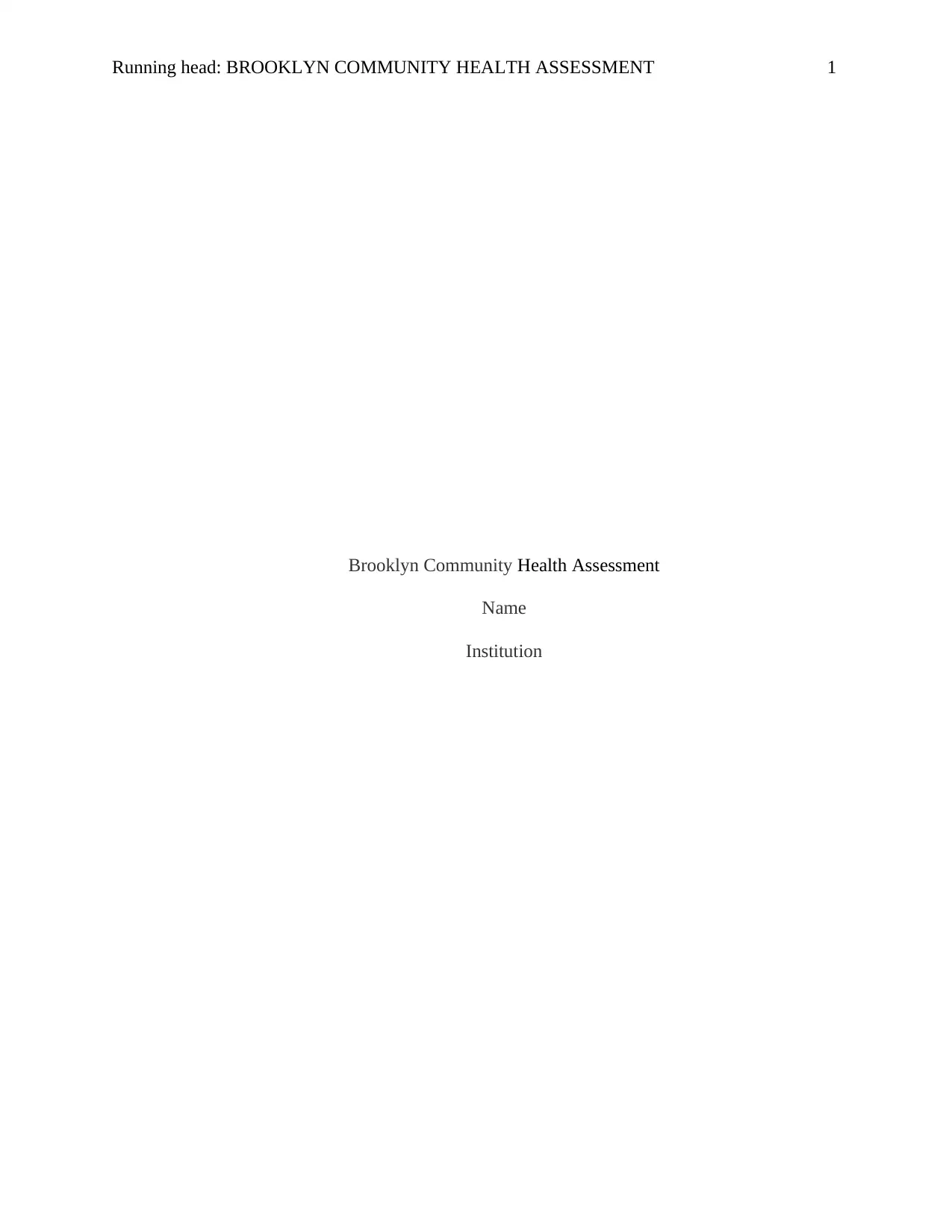
Running head: BROOKLYN COMMUNITY HEALTH ASSESSMENT 1
Brooklyn Community Health Assessment
Name
Institution
Brooklyn Community Health Assessment
Name
Institution
Paraphrase This Document
Need a fresh take? Get an instant paraphrase of this document with our AI Paraphraser
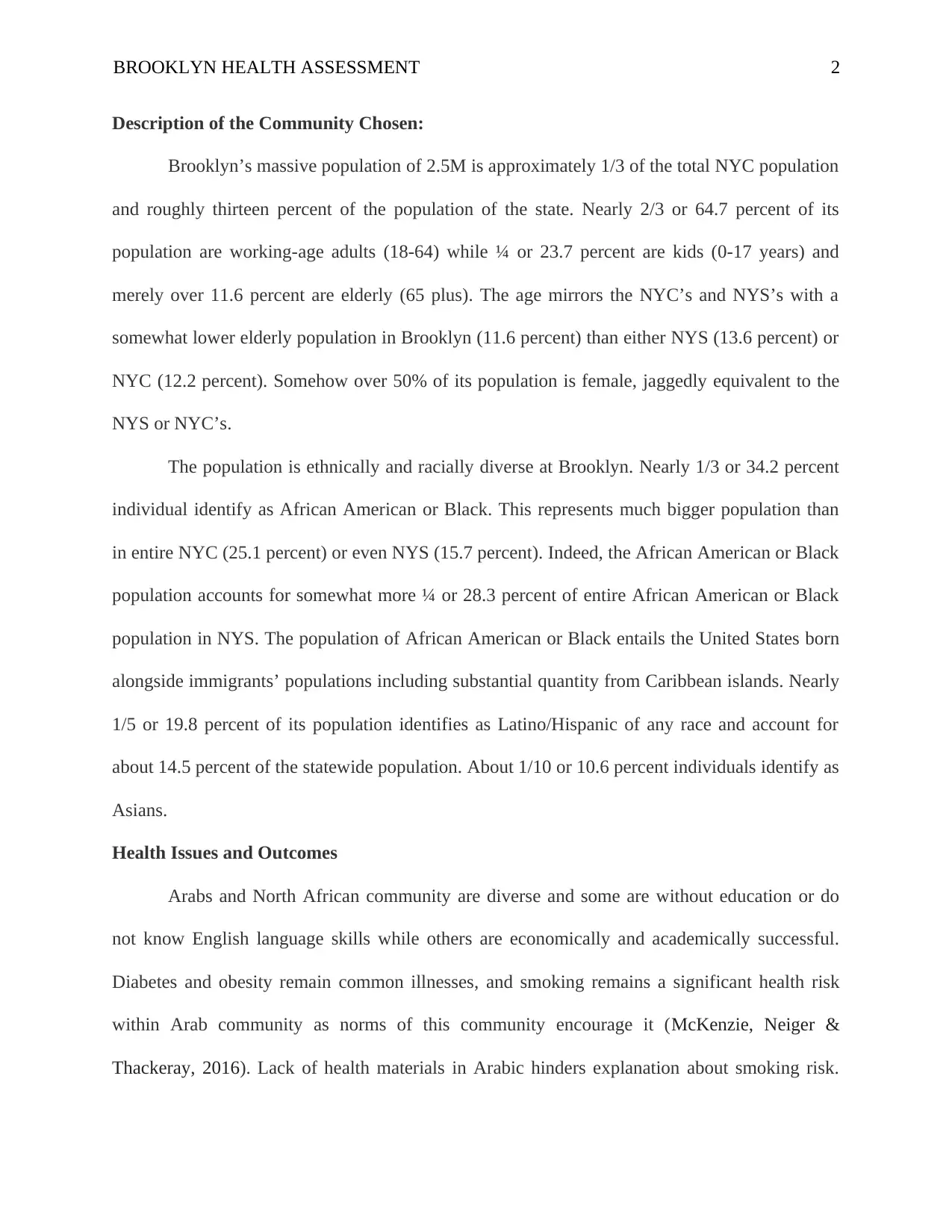
BROOKLYN HEALTH ASSESSMENT 2
Description of the Community Chosen:
Brooklyn’s massive population of 2.5M is approximately 1/3 of the total NYC population
and roughly thirteen percent of the population of the state. Nearly 2/3 or 64.7 percent of its
population are working-age adults (18-64) while ¼ or 23.7 percent are kids (0-17 years) and
merely over 11.6 percent are elderly (65 plus). The age mirrors the NYC’s and NYS’s with a
somewhat lower elderly population in Brooklyn (11.6 percent) than either NYS (13.6 percent) or
NYC (12.2 percent). Somehow over 50% of its population is female, jaggedly equivalent to the
NYS or NYC’s.
The population is ethnically and racially diverse at Brooklyn. Nearly 1/3 or 34.2 percent
individual identify as African American or Black. This represents much bigger population than
in entire NYC (25.1 percent) or even NYS (15.7 percent). Indeed, the African American or Black
population accounts for somewhat more ¼ or 28.3 percent of entire African American or Black
population in NYS. The population of African American or Black entails the United States born
alongside immigrants’ populations including substantial quantity from Caribbean islands. Nearly
1/5 or 19.8 percent of its population identifies as Latino/Hispanic of any race and account for
about 14.5 percent of the statewide population. About 1/10 or 10.6 percent individuals identify as
Asians.
Health Issues and Outcomes
Arabs and North African community are diverse and some are without education or do
not know English language skills while others are economically and academically successful.
Diabetes and obesity remain common illnesses, and smoking remains a significant health risk
within Arab community as norms of this community encourage it (McKenzie, Neiger &
Thackeray, 2016). Lack of health materials in Arabic hinders explanation about smoking risk.
Description of the Community Chosen:
Brooklyn’s massive population of 2.5M is approximately 1/3 of the total NYC population
and roughly thirteen percent of the population of the state. Nearly 2/3 or 64.7 percent of its
population are working-age adults (18-64) while ¼ or 23.7 percent are kids (0-17 years) and
merely over 11.6 percent are elderly (65 plus). The age mirrors the NYC’s and NYS’s with a
somewhat lower elderly population in Brooklyn (11.6 percent) than either NYS (13.6 percent) or
NYC (12.2 percent). Somehow over 50% of its population is female, jaggedly equivalent to the
NYS or NYC’s.
The population is ethnically and racially diverse at Brooklyn. Nearly 1/3 or 34.2 percent
individual identify as African American or Black. This represents much bigger population than
in entire NYC (25.1 percent) or even NYS (15.7 percent). Indeed, the African American or Black
population accounts for somewhat more ¼ or 28.3 percent of entire African American or Black
population in NYS. The population of African American or Black entails the United States born
alongside immigrants’ populations including substantial quantity from Caribbean islands. Nearly
1/5 or 19.8 percent of its population identifies as Latino/Hispanic of any race and account for
about 14.5 percent of the statewide population. About 1/10 or 10.6 percent individuals identify as
Asians.
Health Issues and Outcomes
Arabs and North African community are diverse and some are without education or do
not know English language skills while others are economically and academically successful.
Diabetes and obesity remain common illnesses, and smoking remains a significant health risk
within Arab community as norms of this community encourage it (McKenzie, Neiger &
Thackeray, 2016). Lack of health materials in Arabic hinders explanation about smoking risk.
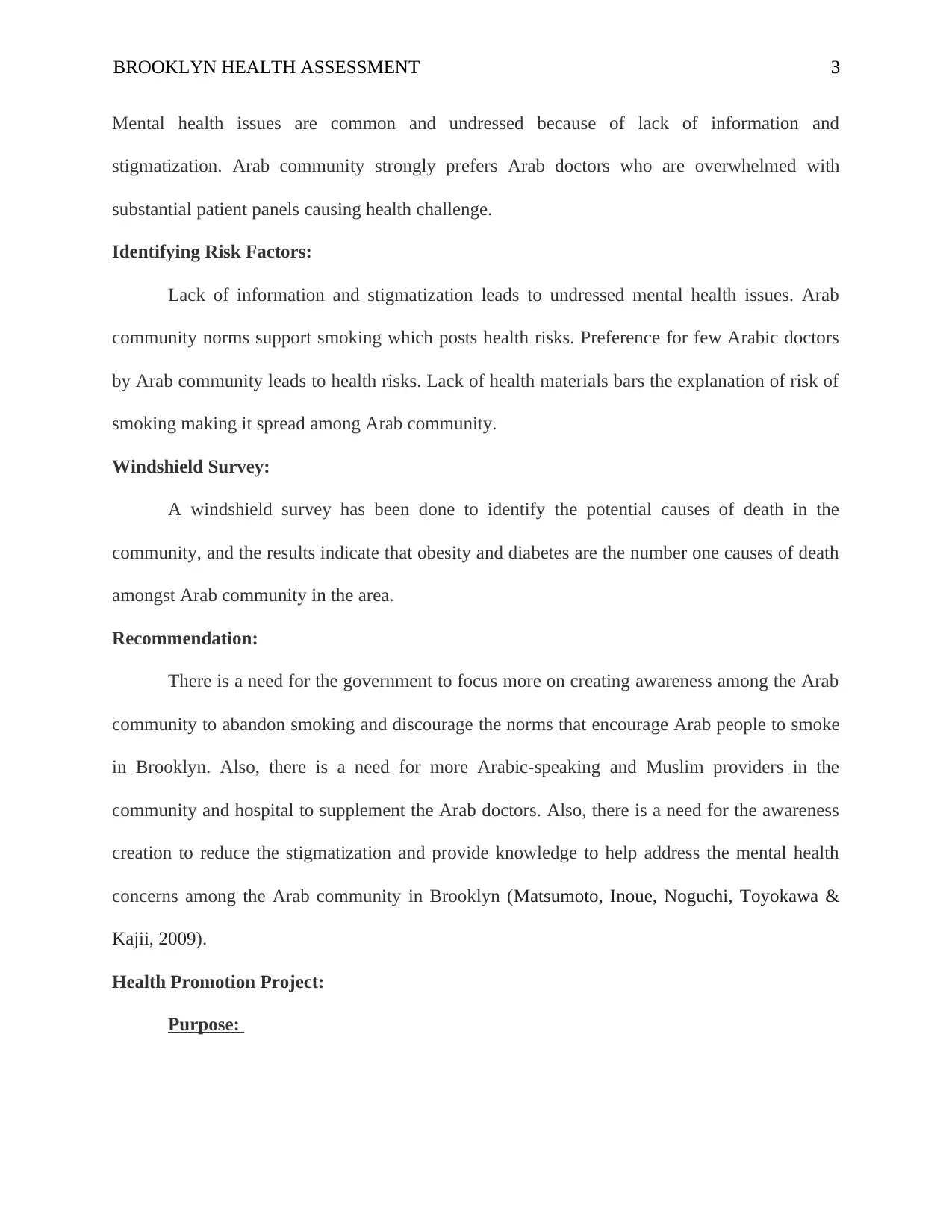
BROOKLYN HEALTH ASSESSMENT 3
Mental health issues are common and undressed because of lack of information and
stigmatization. Arab community strongly prefers Arab doctors who are overwhelmed with
substantial patient panels causing health challenge.
Identifying Risk Factors:
Lack of information and stigmatization leads to undressed mental health issues. Arab
community norms support smoking which posts health risks. Preference for few Arabic doctors
by Arab community leads to health risks. Lack of health materials bars the explanation of risk of
smoking making it spread among Arab community.
Windshield Survey:
A windshield survey has been done to identify the potential causes of death in the
community, and the results indicate that obesity and diabetes are the number one causes of death
amongst Arab community in the area.
Recommendation:
There is a need for the government to focus more on creating awareness among the Arab
community to abandon smoking and discourage the norms that encourage Arab people to smoke
in Brooklyn. Also, there is a need for more Arabic-speaking and Muslim providers in the
community and hospital to supplement the Arab doctors. Also, there is a need for the awareness
creation to reduce the stigmatization and provide knowledge to help address the mental health
concerns among the Arab community in Brooklyn (Matsumoto, Inoue, Noguchi, Toyokawa &
Kajii, 2009).
Health Promotion Project:
Purpose:
Mental health issues are common and undressed because of lack of information and
stigmatization. Arab community strongly prefers Arab doctors who are overwhelmed with
substantial patient panels causing health challenge.
Identifying Risk Factors:
Lack of information and stigmatization leads to undressed mental health issues. Arab
community norms support smoking which posts health risks. Preference for few Arabic doctors
by Arab community leads to health risks. Lack of health materials bars the explanation of risk of
smoking making it spread among Arab community.
Windshield Survey:
A windshield survey has been done to identify the potential causes of death in the
community, and the results indicate that obesity and diabetes are the number one causes of death
amongst Arab community in the area.
Recommendation:
There is a need for the government to focus more on creating awareness among the Arab
community to abandon smoking and discourage the norms that encourage Arab people to smoke
in Brooklyn. Also, there is a need for more Arabic-speaking and Muslim providers in the
community and hospital to supplement the Arab doctors. Also, there is a need for the awareness
creation to reduce the stigmatization and provide knowledge to help address the mental health
concerns among the Arab community in Brooklyn (Matsumoto, Inoue, Noguchi, Toyokawa &
Kajii, 2009).
Health Promotion Project:
Purpose:
⊘ This is a preview!⊘
Do you want full access?
Subscribe today to unlock all pages.

Trusted by 1+ million students worldwide
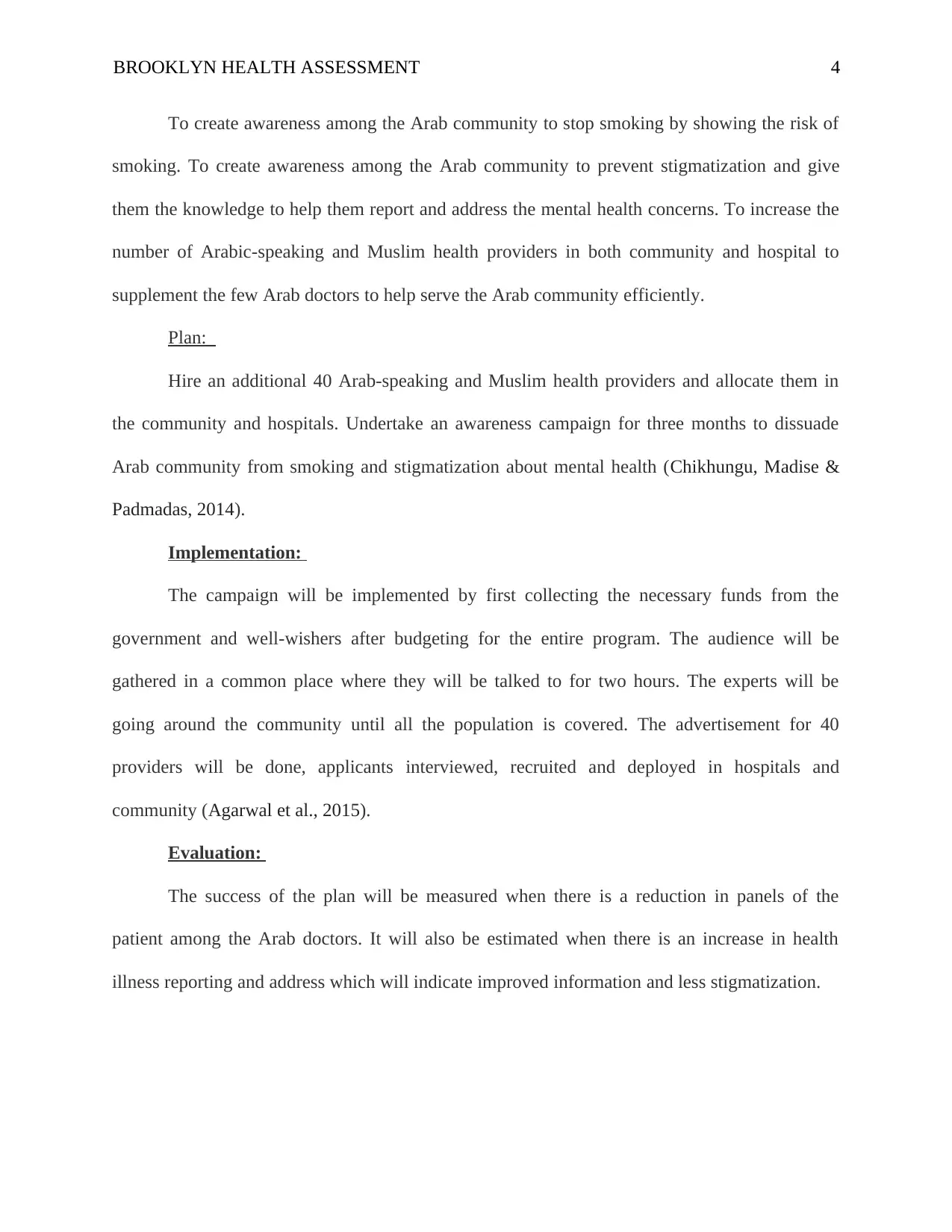
BROOKLYN HEALTH ASSESSMENT 4
To create awareness among the Arab community to stop smoking by showing the risk of
smoking. To create awareness among the Arab community to prevent stigmatization and give
them the knowledge to help them report and address the mental health concerns. To increase the
number of Arabic-speaking and Muslim health providers in both community and hospital to
supplement the few Arab doctors to help serve the Arab community efficiently.
Plan:
Hire an additional 40 Arab-speaking and Muslim health providers and allocate them in
the community and hospitals. Undertake an awareness campaign for three months to dissuade
Arab community from smoking and stigmatization about mental health (Chikhungu, Madise &
Padmadas, 2014).
Implementation:
The campaign will be implemented by first collecting the necessary funds from the
government and well-wishers after budgeting for the entire program. The audience will be
gathered in a common place where they will be talked to for two hours. The experts will be
going around the community until all the population is covered. The advertisement for 40
providers will be done, applicants interviewed, recruited and deployed in hospitals and
community (Agarwal et al., 2015).
Evaluation:
The success of the plan will be measured when there is a reduction in panels of the
patient among the Arab doctors. It will also be estimated when there is an increase in health
illness reporting and address which will indicate improved information and less stigmatization.
To create awareness among the Arab community to stop smoking by showing the risk of
smoking. To create awareness among the Arab community to prevent stigmatization and give
them the knowledge to help them report and address the mental health concerns. To increase the
number of Arabic-speaking and Muslim health providers in both community and hospital to
supplement the few Arab doctors to help serve the Arab community efficiently.
Plan:
Hire an additional 40 Arab-speaking and Muslim health providers and allocate them in
the community and hospitals. Undertake an awareness campaign for three months to dissuade
Arab community from smoking and stigmatization about mental health (Chikhungu, Madise &
Padmadas, 2014).
Implementation:
The campaign will be implemented by first collecting the necessary funds from the
government and well-wishers after budgeting for the entire program. The audience will be
gathered in a common place where they will be talked to for two hours. The experts will be
going around the community until all the population is covered. The advertisement for 40
providers will be done, applicants interviewed, recruited and deployed in hospitals and
community (Agarwal et al., 2015).
Evaluation:
The success of the plan will be measured when there is a reduction in panels of the
patient among the Arab doctors. It will also be estimated when there is an increase in health
illness reporting and address which will indicate improved information and less stigmatization.
Paraphrase This Document
Need a fresh take? Get an instant paraphrase of this document with our AI Paraphraser
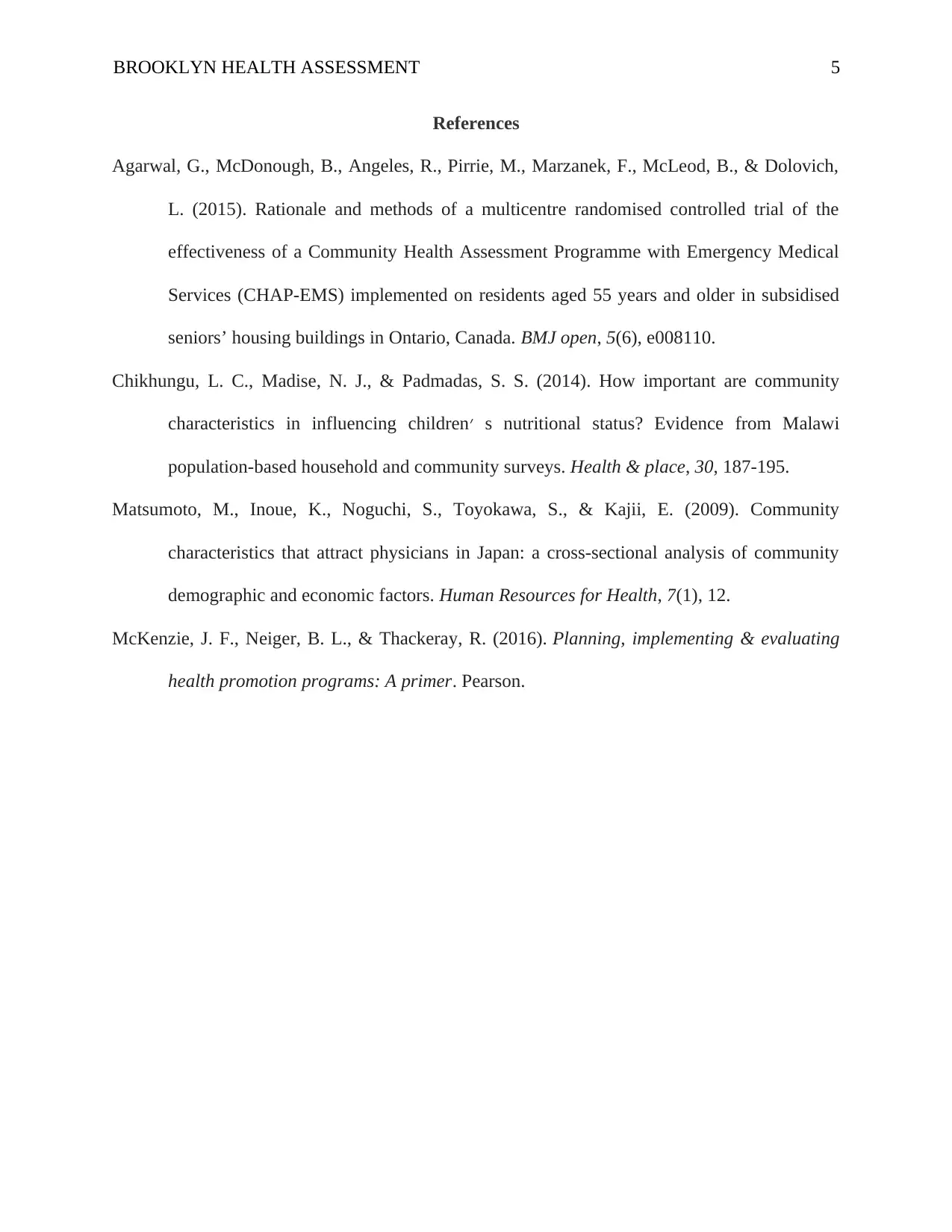
BROOKLYN HEALTH ASSESSMENT 5
References
Agarwal, G., McDonough, B., Angeles, R., Pirrie, M., Marzanek, F., McLeod, B., & Dolovich,
L. (2015). Rationale and methods of a multicentre randomised controlled trial of the
effectiveness of a Community Health Assessment Programme with Emergency Medical
Services (CHAP-EMS) implemented on residents aged 55 years and older in subsidised
seniors’ housing buildings in Ontario, Canada. BMJ open, 5(6), e008110.
Chikhungu, L. C., Madise, N. J., & Padmadas, S. S. (2014). How important are community
characteristics in influencing children׳ s nutritional status? Evidence from Malawi
population-based household and community surveys. Health & place, 30, 187-195.
Matsumoto, M., Inoue, K., Noguchi, S., Toyokawa, S., & Kajii, E. (2009). Community
characteristics that attract physicians in Japan: a cross-sectional analysis of community
demographic and economic factors. Human Resources for Health, 7(1), 12.
McKenzie, J. F., Neiger, B. L., & Thackeray, R. (2016). Planning, implementing & evaluating
health promotion programs: A primer. Pearson.
References
Agarwal, G., McDonough, B., Angeles, R., Pirrie, M., Marzanek, F., McLeod, B., & Dolovich,
L. (2015). Rationale and methods of a multicentre randomised controlled trial of the
effectiveness of a Community Health Assessment Programme with Emergency Medical
Services (CHAP-EMS) implemented on residents aged 55 years and older in subsidised
seniors’ housing buildings in Ontario, Canada. BMJ open, 5(6), e008110.
Chikhungu, L. C., Madise, N. J., & Padmadas, S. S. (2014). How important are community
characteristics in influencing children׳ s nutritional status? Evidence from Malawi
population-based household and community surveys. Health & place, 30, 187-195.
Matsumoto, M., Inoue, K., Noguchi, S., Toyokawa, S., & Kajii, E. (2009). Community
characteristics that attract physicians in Japan: a cross-sectional analysis of community
demographic and economic factors. Human Resources for Health, 7(1), 12.
McKenzie, J. F., Neiger, B. L., & Thackeray, R. (2016). Planning, implementing & evaluating
health promotion programs: A primer. Pearson.
1 out of 5
Your All-in-One AI-Powered Toolkit for Academic Success.
+13062052269
info@desklib.com
Available 24*7 on WhatsApp / Email
![[object Object]](/_next/static/media/star-bottom.7253800d.svg)
Unlock your academic potential
Copyright © 2020–2025 A2Z Services. All Rights Reserved. Developed and managed by ZUCOL.